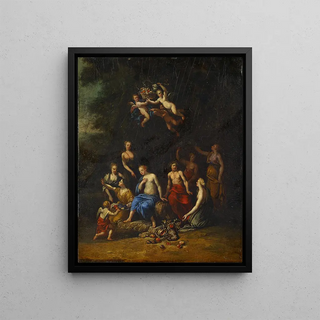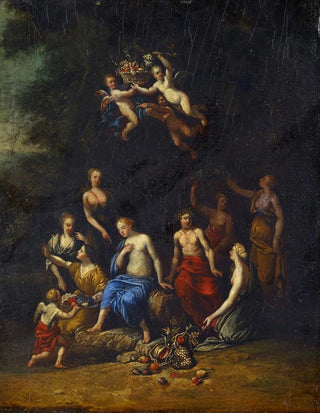Art print | Bacchus and Pomona - Gerard de Lairesse Source: Reproduction | Bacchus et Pomone - Gerard de Lairesse


View from behind

Frame (optional)
In the fascinating world of baroque art, the artwork "Bacchus and Pomona" by Gerard de Lairesse stands out for its brilliance and boldness. This painting, imbued with mythology and sensuality, invites the viewer to immerse themselves in a universe where nature and divinity intertwine harmoniously. The scene depicts a meeting between Bacchus, the god of wine, and Pomona, the goddess of fruits, symbolizing fertility and abundance. The vibrant composition and shimmering colors of this piece capture the very essence of joie de vivre, while also evoking a certain melancholy inherent to the human condition. Contemplating this art print Bacchus and Pomona - Gerard de Lairesse, one feels invited to celebrate the simple pleasures of life.
Style and uniqueness of the work
Gerard de Lairesse's style is characterized by a remarkable mastery of forms and colors. In "Bacchus and Pomona," he employs a rich and harmonious palette, where golden hues and shades of green blend to create an atmosphere that is both festive and soothing. The characters are depicted with refined elegance, their postures and expressions conveying emotional depth that surpasses mere visual aspect. The fluid movement of the drapery and the luminosity of the faces add an almost lifelike dimension to the scene, inviting the viewer to feel the intensity of the moment. Lairesse, a true virtuoso, manages to capture the essence of his characters while incorporating elements of nature, such as vines and fruits, which strengthen the link between the divine and the earthly.
The artist and his influence
Gerard de Lairesse, born in the Netherlands in the 17th century, was an artist whose influence has spanned the ages. Raised in an environment where art was celebrated, he managed to establish himself as a master of baroque, combining Flemish traditions with a sensitivity unique to his era. His work is not limited to painting; he also contributed to art theory, writing treatises that shaped the

Matte finish

View from behind

Frame (optional)
In the fascinating world of baroque art, the artwork "Bacchus and Pomona" by Gerard de Lairesse stands out for its brilliance and boldness. This painting, imbued with mythology and sensuality, invites the viewer to immerse themselves in a universe where nature and divinity intertwine harmoniously. The scene depicts a meeting between Bacchus, the god of wine, and Pomona, the goddess of fruits, symbolizing fertility and abundance. The vibrant composition and shimmering colors of this piece capture the very essence of joie de vivre, while also evoking a certain melancholy inherent to the human condition. Contemplating this art print Bacchus and Pomona - Gerard de Lairesse, one feels invited to celebrate the simple pleasures of life.
Style and uniqueness of the work
Gerard de Lairesse's style is characterized by a remarkable mastery of forms and colors. In "Bacchus and Pomona," he employs a rich and harmonious palette, where golden hues and shades of green blend to create an atmosphere that is both festive and soothing. The characters are depicted with refined elegance, their postures and expressions conveying emotional depth that surpasses mere visual aspect. The fluid movement of the drapery and the luminosity of the faces add an almost lifelike dimension to the scene, inviting the viewer to feel the intensity of the moment. Lairesse, a true virtuoso, manages to capture the essence of his characters while incorporating elements of nature, such as vines and fruits, which strengthen the link between the divine and the earthly.
The artist and his influence
Gerard de Lairesse, born in the Netherlands in the 17th century, was an artist whose influence has spanned the ages. Raised in an environment where art was celebrated, he managed to establish himself as a master of baroque, combining Flemish traditions with a sensitivity unique to his era. His work is not limited to painting; he also contributed to art theory, writing treatises that shaped the






